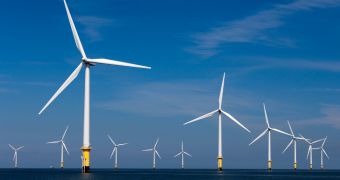As if greenheads needed any more reasons to like wind farms, it would appear that such collections of turbines might help reduce not only hurricane wind speeds, but also storm surge if and when installed in coastal areas.
Or at least this is what a team of researchers writing in a recent issue of the journal Nature Climate Change would have us believe.
In this paper, specialists detail that, in order to assess how massive offshore wind turbine arrays would influence hurricane wind speeds and storm surge, they pieced together several computer models.
According to Mongabay, the researchers made use of data concerning the behavior of hurricanes Katrina and Isaac in their investigation, and analyzed the atmospheric effects of several wind turbine arrays.
The offshore farms that they focused on were of different sizes and densities, yet they were all installed at a distance of 100 kilometers tops (roughly 62 miles) from the United States' coastline.
It was discovered that, had as many as 78,000 wind turbines been operating off the coast of New Orleans at the time Katrina hit, the hurricane's wind speeds would have been not 140 miles per hour (62.6 meters per second), but 50.2 miles per hour (26.5 meters per second).
What's more, the storm surge accompanying hurricane Katrina would have been reduced by as much as 71%, the Stanford University and the University of Delaware researchers maintain.
Needless to say, this means that the overall damage that said hurricane caused to the areas it hit would have also been reduced to a considerable extent.
Some might argue that installing thousands of offshore wind turbines in an attempt to reduce damage caused by hurricane winds and storm surges hardly makes sense financially-wise.
More so given the fact that the London Array, which is currently the world's largest offshore wind farm, encompasses just 176 turbines and cost an impressive $3 billion (€2.17 billion) to build.
However, the Stanford University and the University of Delaware specialists argue that, when considering the fact that wind turbines don't just protect people against natural disasters but also generate clean, cheap electricity, the idea suddenly becomes quite appealing.
“If wind turbines are used only for hurricane damage avoidance, an array covering 32 kilometers (almost 20 miles) of linear coastline in front of New York City would cost some $210 billion (roughly €152 billion) with no payback,” the researchers write in their paper.
“However, turbines pay for themselves from the sale of electricity they produce and other non-market benefits. Sea walls have no other function than to reduce storm surge (they do not even reduce damaging hurricane wind speeds), so society bears their full cost,” they go on to explain.

 14 DAY TRIAL //
14 DAY TRIAL //